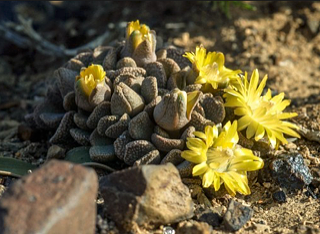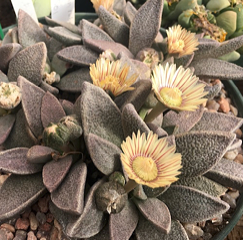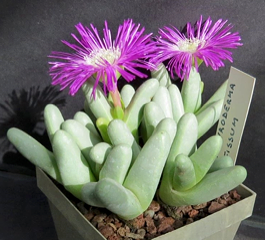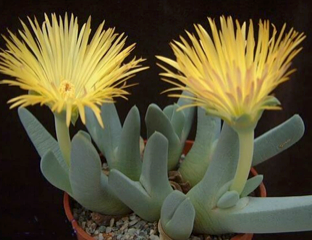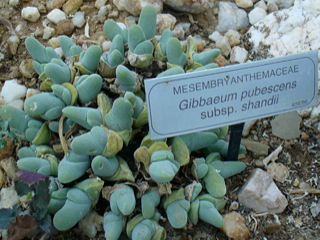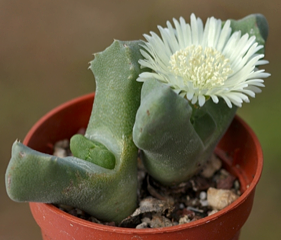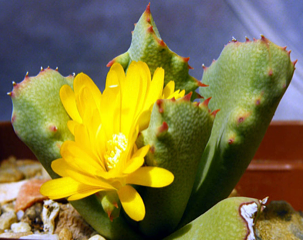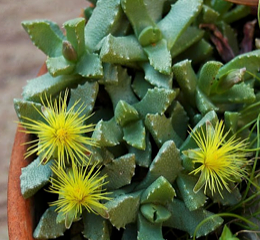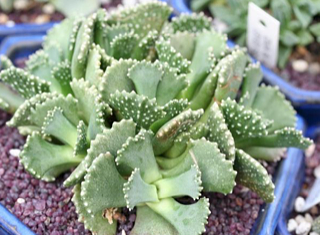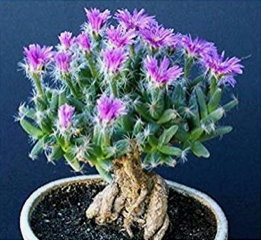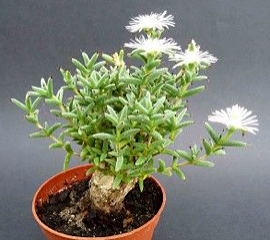Submitted by: Jim Tanner
Mesembs form a major and unique component of southern Africa’s arid land flora. Succulent leaves, bright shiny-petalled flowers and hygrochastic fruit (capsules open when it rains) characterize the group. Mesembs are extremely diverse, particularly so in the Succulent Karoo Region, although they have a strong presence in the Fynbos. Some of the more primitive groups are almost entirely confined to Fynbos, suggesting that the Fynbos Biome may have acted as a mesic refuge for the semi-succulent members of this group. Mesembs are the subjects of a huge trade in ‘curiosity plants’ among succulent collectors. They display features not seen elsewhere in the plant kingdom. The combination of minutism, mimicry and extreme succulence accounts for much of the variation in form and bizarre shapes that add to their appeal.
Mesembs are annual to perennial succulents, ranging from minute to compact and tufted to prostrate to decumbent; herbs, dwarf shrubs, subshrubs or shrubs, they are rarely spiny. The leaves are opposite, rarely alternate, simple, free at the base to almost completely united into single, conical and spherical bodies, often sheathing the stem. Their shape may be flat to 3-angled to cylindrical. All leaves may be similar or different types of leaf pairs may be present, members of a leaf pair may be similar or dissimilar.
Mesembs comprise 127 genera and about 1,700 species, and account for 63% of southern Africa’s succulent flora, and almost 10% of South Africa’s Flora. Modern taxonomic interpretation places this group into the family Aizoaceae, although the old family name Mesembryanthemaceae is still used. This family is comparable in size to the New World Cactaceae, also an arid area specialist group. Mesembs occur mostly in the southwestern parts of the African continent, from Angola down to the Western Cape Province, extending well into the east over the central plateau of South Africa and reaching into Zimbabwe and Botswana. They dominate vegetation in the Succulent Karoo Region. This winter rainfall desert constitutes the world’s only arid biodiversity ‘hotspot’ of the 25 recognized globally. The family is almost entirely endemic to southern Africa with only about 20 species occurring naturally elsewhere.
LATIN LOOKUP – Loquerisne Latine (Do you speak Latin)?
The meanings of latin plant names on this page – from http://davesgarden.com/guides/botanary/
- Aloinopsis [al-low-in-OP-sis]
Aloe-like. - Argyroderma [ar-gy-ro-DERM-uh]
1. Silver skin.
2. From the Greek words argyros (silver) and derma (skin). - calcarea [kal-KAR-ee-uh]
Of chalky land. - Cheiridopsis [kye-rid-OP-sis]
From the Greek cheiris (sheath) and opsis (resembling), referring to the leaves forming a sheath covering the emerging leaves. - crassum [KRASS-um]
Thick, fleshy, dense or fat. - Delosperma [del-oh-SPUR-muh]
Obvious seed. - densum [DEN-sum]
Compact, dense. - fissum [FIZ-zum, FIS-sum]
From the Latin fissura, to split or crack. - Gibbaeum [GIB-bay-um]
from the Latin gibba (hump), for the humped leaves of each leaf pair. - marlothii [mar-LOTH-ee-eye]
Named after Hermann Wilhelm Rudolph Marloth, 19th century German botanist and author in South Africa. - mirabile [mih-RAB-ih-ley]
Wonderful. - nanus [NAN-us]
Small, dwarf. - Odontophorus [oh-don-to-FOR-us]
Bearing (carrying) teeth. - pubescens [pew-BES-senz, pub-ess-ens]
Downy, short haired. - rubrolineata [roo-bro-lin-ee-AY-tuh]
Red Lined. - Schwantesia [shwan-TEZ-ee-uh]
Named for Dr. Martin Heinrich Gustav Schwantes, 20th century German botanist specializing in Mesembs. - shandii [SHAN-dee-eye]
For John Shand, 20th century magistrate in Ladsmith, South Africa. - spathulata [spath-yoo-LAY-tuh]
With a small spathe. - Stomatium [sto-MAH-tee-um, sto-MAY-tee-um]
From the Greek stoma (mouth). - Titanopsis [ty-tan-OP-sis]
Resembles Titan, the sun god; referring to the flower’s resemblance to the sun. - Trichodiadema [try-koh-dy-uh-DEE-ma]
From the Greek thirix (hair) and diadema (band around the head); referring to the crown of bristles on the leaf tips.
